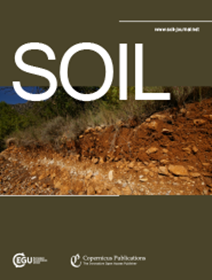High biodegradability of water-soluble organic carbon in soils at the southern margin of the boreal forest
IF 4.3
2区 农林科学
Q1 SOIL SCIENCE
引用次数: 0
Abstract
Abstract. Water-soluble organic carbon (WSOC) is an important component of the organic carbon pool in boreal ecosystems. However, the biodegradability of WSOC across various soil depths in boreal ecosystems remains unclear. Here, based on spectroscopic techniques, we conducted a 28-day laboratory incubation to analyze the molecular composition, biodegradability, and compositional changes of WSOC at different soil depths in a southern region of the boreal forest. The results showed that in the upper 2 m soils, the average content of biodegradable WSOC was 0.228 g/kg with an average proportion of 86.41 % in the total WSOC. In the deep soils below 2 m, the average content of biodegradable WSOC content was 0.144 g/kg, comprising 80.79 % of the total WSOC. Spectroscopic analysis indicates that the WSOC in the upper soils is primarily composed of highly aromatic humic acid-like matter with larger molecular weights than those in deep soils. Both the aromaticity and molecular weight decrease with depth, and the WSOC is mainly composed of fulvic acid-like matter in the deep soils, suggesting high biodegradability of WSOC in the deep soils. Overall, our results suggest that the water-soluble organic carbon in the boreal forests exhibits high biodegradability both in the shallow layer and deep soils.北方针叶林南缘土壤水溶性有机碳的高生物降解性
摘要。水溶性有机碳(WSOC)是北方生态系统有机碳库的重要组成部分。然而,北方生态系统中不同土壤深度的水有机碳可生物降解性尚不清楚。在此,我们基于光谱技术进行了28天的实验室培养,分析了北方针叶林南部不同土壤深度下WSOC的分子组成、生物降解性和组成变化。结果表明:上层2 m土壤中可生物降解的WSOC平均含量为0.228 g/kg,占总WSOC的平均比例为86.41%;在2 m以下深层土壤中,可生物降解的WSOC平均含量为0.144 g/kg,占总WSOC的80.79%。光谱分析表明,表层土壤水分有机碳主要由分子量较大的高芳香腐植酸类物质组成。芳香性和分子量均随深度的增加而降低,深层土壤中土壤有机碳主要以黄腐酸类物质为主,具有较高的生物降解性。总体而言,我们的研究结果表明,北方森林中水溶性有机碳在浅层和深层土壤中都具有较高的生物降解性。
本文章由计算机程序翻译,如有差异,请以英文原文为准。
求助全文
约1分钟内获得全文
求助全文
来源期刊

Soil
Agricultural and Biological Sciences-Soil Science
CiteScore
10.80
自引率
2.90%
发文量
44
审稿时长
30 weeks
期刊介绍:
SOIL is an international scientific journal dedicated to the publication and discussion of high-quality research in the field of soil system sciences.
SOIL is at the interface between the atmosphere, lithosphere, hydrosphere, and biosphere. SOIL publishes scientific research that contributes to understanding the soil system and its interaction with humans and the entire Earth system. The scope of the journal includes all topics that fall within the study of soil science as a discipline, with an emphasis on studies that integrate soil science with other sciences (hydrology, agronomy, socio-economics, health sciences, atmospheric sciences, etc.).
 求助内容:
求助内容: 应助结果提醒方式:
应助结果提醒方式:


